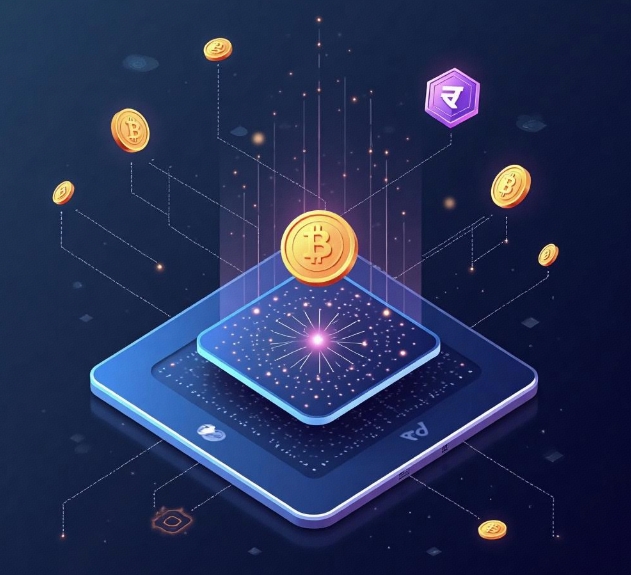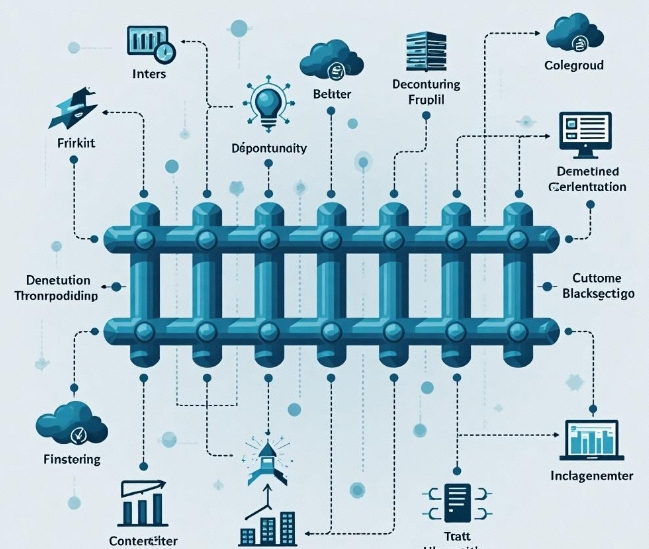DApp Development and Blockchain Technology: An In-depth Analysis of Their Relationship
- latest articles
- 1.DApp Development & Customization: Merging Diverse Market Needs with User Experience 2.Analysis of the Core Technical System in DApp Project Development 3.How to achieve cross-chain interoperability in Web3 projects? 4.How does the tokenization of points reconstruct the e-commerce ecosystem? 5.How to Set and Track Data Metrics for a Points Mall? 6.What is DApp Development? Core Concepts and Technical Analysis 7.Inventory of commonly used Web3 development tools and usage tips 8.Development of a Distribution System Integrated with Social E-commerce 9.Six Key Steps for Businesses to Build a Points Mall System 10.What is DApp Development? A Comprehensive Guide from Concept to Implementation
- Popular Articles
- 1.Future Trends and Technology Predictions for APP Development in 2025 2.Analysis of the DeFi Ecosystem: How Developers Can Participate in Decentralized Finance Innovation 3.From Zero to One: How PI Mall Revolutionizes the Traditional E-commerce Model 4.DAPP Development | Best Practices for Professional Customization and Rapid Launch 5.Recommended by the Web3 developer community: the most noteworthy forums and resources 6.From Cloud Computing to Computing Power Leasing: Building a Flexible and Scalable Computing Resource Platform 7.How to Develop a Successful Douyin Mini Program: Technical Architecture and Best Practices 8.Shared Bike System APP: The Convenient Choice in the Era of Smart Travel 9.How to Create a Successful Dating App: From Needs Analysis to User Experience Design 10.From Design to Development: The Complete Process of Bringing an APP Idea to Life
With the rapid development of blockchain technology, various new decentralized applications (DApps) have gradually entered the public's view, becoming a focal point of attention in the technology, finance, and broader fields. From smart contracts to decentralized finance (DeFi), blockchain offers unprecedented possibilities for various applications. As a specific application form of blockchain technology, DApps, with their characteristics of decentralization, transparency, and immutability, are transforming the development and operational models of traditional internet applications.
This article will delve into the definition of DApps, the fundamental principles of blockchain technology, and the relationship between the two, helping readers better understand the process of DApp development and the principles behind blockchain technology.
I. Definition and Characteristics of DApps
1.1 Definition of DApps
DApps (Decentralized Applications) are applications developed using blockchain technology that rely on the decentralized nature of blockchain networks to run directly on the blockchain. Unlike traditional applications that depend on a single server or centralized database, DApps achieve data storage, transactions, and application logic execution through smart contracts and node consensus within the blockchain network.
Compared to traditional applications, DApps have several notable characteristics:
Decentralization: The backend infrastructure of DApps is entirely distributed across the blockchain network, with no single server or controlling entity. The failure or interruption of any node does not affect the overall operation of the application.
Transparency: All transactions and operations are recorded on the blockchain and can be queried and verified by anyone. This transparency not only enhances system trust but also reduces risks caused by information asymmetry.
Immutability: Once data is written to the blockchain, it cannot be modified or deleted, ensuring data security and integrity.
Incentive Mechanisms: Most DApps use cryptocurrencies or other tokens to incentivize user participation in network activities, such as contributing computational resources or providing data.
1.2 Application Scenarios of DApps
DApps can be applied in various fields, including but not limited to:
Decentralized Finance (DeFi): Such as decentralized exchanges (DEX), lending platforms, and derivatives trading.
Non-Fungible Tokens (NFTs): Through DApps, users can create, trade, and manage NFT assets, promoting decentralized management of digital art, gaming assets, and more.
Supply Chain Management: Using DApps to achieve supply chain transparency, track product origins and flows, and improve supply chain efficiency and trust.
Governance Platforms: Such as DAOs (Decentralized Autonomous Organizations), which enable decentralized governance and decision-making among community members through smart contracts.
II. Overview of Blockchain Technology
Blockchain is the technological foundation upon which DApps exist, with core characteristics including decentralization, transparency, immutability, and consensus mechanisms. To deeply understand the operational principles of DApps, we first need to grasp the basic components of blockchain technology.
2.1 How Blockchain Works
Blockchain is a distributed database with a data storage structure composed of blocks linked in chronological order. Each block contains a set of transaction data and a hash pointing to the previous block, ensuring data immutability. Once a block is generated and added to the chain, its content cannot be altered.
The blockchain network achieves data storage and synchronization through decentralized nodes, with each node maintaining a copy of the entire blockchain data. Through consensus mechanisms (such as PoW, PoS, etc.), nodes in the network can agree on the generation of new blocks, ensuring network security and data validity.
2.2 Smart Contracts
Smart contracts are a crucial component of blockchain technology, referring to automated protocols executed via the blockchain. They are pieces of code that automatically execute contract terms when specific conditions are met, eliminating the need for manual intervention and third-party intermediaries. The widespread application of smart contracts makes the implementation of decentralized applications possible. For example, Ethereum's smart contract platform allows developers to build and deploy decentralized applications.
2.3 Consensus Mechanisms
Consensus mechanisms are a key concept in blockchain networks, ensuring that all nodes can reach agreement on data consistency in a distributed environment. Common consensus mechanisms include:
Proof of Work (PoW): Nodes compete for the right to record new blocks by computing hash values, used in blockchain networks like Bitcoin.
Proof of Stake (PoS): The right to record blocks is determined by the number of tokens a node holds, which is more energy-efficient and used in networks like Ethereum 2.0.
Delegated Proof of Stake (DPoS): A subset of representative nodes is elected to record blocks, often used to improve the efficiency of blockchain networks.
III. The Relationship Between DApp Development and Blockchain Technology
3.1 DApps Rely on Core Blockchain Features
DApps are closely related to blockchain, and their relationship can be analyzed from the following aspects:
Decentralization: Blockchain provides the decentralized foundation for DApps. DApps do not rely on traditional servers or centralized platforms, thus avoiding data tampering and single points of failure, ensuring application stability and security.
Transparency and Trust Mechanisms: The transparency of blockchain allows DApp data and transactions to be publicly queried, reducing reliance on central authorities for information verification and enhancing overall system trust.
Smart Contracts: The smart contract technology provided by blockchain enables DApps to automate the execution of contract terms, reducing manual intervention and operational costs. The self-executing nature of smart contracts also provides technical assurance for decentralized finance and other application areas.
Disintermediation: Traditional applications often rely on third-party intermediaries, such as banks and payment platforms. Blockchain technology, through the automated execution of smart contracts, achieves disintermediation, reducing intermediary fees and improving efficiency.
3.2 Technical Challenges in DApp Development
Although blockchain offers many advantages for DApp development, several technical challenges remain in practice:
Performance Issues: Currently, most blockchain networks have low transaction processing speeds, and scalability remains a significant issue. This places high demands on the user experience of DApps, especially in scenarios requiring high-frequency transactions or large-scale data processing, where performance bottlenecks can directly impact application smoothness.
Smart Contract Security: Once smart contract code is deployed on the blockchain, it cannot be changed, making vulnerabilities potential attack points. There have been multiple security incidents in history due to smart contract vulnerabilities, so developers must pay special attention to contract security and auditing.
User Experience: Due to the complexity of blockchain technology, DApp user experiences are often less user-friendly, requiring users to have some technical background to use DApps smoothly. Reducing the operational barrier for users and improving usability is an important direction for DApp development.
3.3 Blockchain Platforms and DApp Development
Currently, several blockchain platforms provide the infrastructure and tools for DApp development, such as Ethereum, EOS, Polkadot, and Solana.
Ethereum: As the earliest smart contract platform, Ethereum offers a complete development framework for DApp developers, including the Solidity programming language and the Truffle development framework.
EOS: EOS provides higher transaction throughput and lower transaction costs, making it suitable for DApps requiring high-frequency transactions.
Polkadot: Polkadot is a cross-chain interoperable blockchain platform that supports communication between different blockchains, offering broader application scenarios for DApps.
Solana: Known for its high throughput and low latency, Solana has become a popular platform for high-frequency trading and DeFi applications.
IV. Future Development Trends of DApps
With the continuous advancement of blockchain technology and the expansion of application scenarios, DApps will demonstrate greater development potential in the future.
4.1 Enhanced Interoperability
Currently, there is a lack of effective interoperability between different blockchain platforms, which limits cross-chain applications of DApps. In the future, with the development of cross-chain technology, DApps will be able to operate seamlessly across multiple blockchain platforms, achieving broader connectivity.
4.2 Improved User Experience
To address the complexity of blockchain applications, DApps will increasingly focus on optimizing user experience, including simplifying operational processes, providing more intuitive interfaces, and reducing transaction costs.
4.3 Further Innovation in DeFi and NFTs
Decentralized Finance (DeFi) and Non-Fungible Tokens (NFTs) will continue to be two important directions for DApp development. As technology matures, DeFi platforms will offer more diverse financial services, while NFTs will gradually expand beyond art trading into areas such as gaming, entertainment, and identity verification.
4.4 Regulatory Compliance
As DApps become more widely used in fields like finance, regulatory attention to blockchain and cryptocurrencies is increasing. In the future, DApp developers will need to pay more attention to compliance issues, ensuring that applications adhere to relevant laws and regulations to avoid risks.
Conclusion
As a significant application of blockchain technology, DApps are leading the wave of innovation in internet technology. Through decentralized architecture and the automated execution of smart contracts, they greatly enhance data security, transparency, and efficiency. Although numerous challenges remain in the development and application of DApps, with continuous technological advancement and refinement, the future prospects for DApps are vast, and they are poised to play an important role in many more fields.
The relationship between blockchain technology and DApps is like two wings that complement each other: blockchain provides a solid technological foundation for DApps, while DApps maximize the value and potential of blockchain. As both continue to evolve, the widespread adoption of decentralized applications will profoundly transform our digital lives.
-

DApp Development & Customization: Merging Diverse Market Needs with User Experience
As blockchain technology matures and becomes more widespread, decentralized appl···
-

Analysis of the Core Technical System in DApp Project Development
With the rapid development of blockchain technology, decentralized applications ···
-

What is DApp Development? Core Concepts and Technical Analysis
With the rapid development of blockchain technology, decentralized applications ···

 Blockchain
Blockchain












